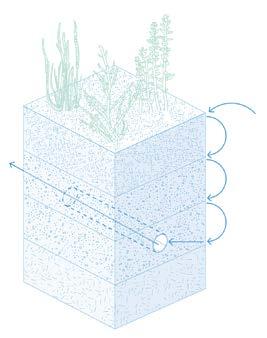
4 minute read
Reuse Plot Choices
from Canvey Concept
The majority of property plots will fall under this category. In order to keep the houses of Canvey Island from becoming abandoned, each resident that lives in one of these plots will be given different options for the fate of their home. This gives the power of design to the residents of the island. Since they are the experts on what their neighbours would enjoy the most, they will be able to pick the best option for their home’s transformation.
Once the resident passes on, the house would go into a deconstruction phase, which would be carefully taken apart and inventoried for use in the next phase or stored in a material warehouse on Canvey Island. The strategies below would unlock new public spaces for the community while also adding to the island’s biodiversity. Selling the house would be a last resort but an option if new residents were interested in some properties.
Advertisement

FIGURE 17
Author’s Own
As the woodland gets older, some trees will succeed in taking over other trees based on exposure to the sun, water, wind, and foot traffic.
(Sub)Urban Woodland
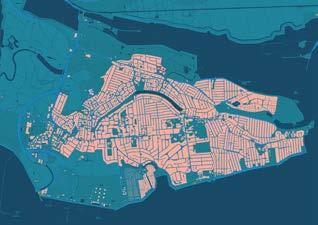
As more and more homes choose this option, Canvey Island would turn into a series of these tiny woodlands, creating a rich ecology of new species prepared for a changing climate. Forest Research has been studying what species of trees can cope with generally higher temperatures, heavy rainfall during the colder seasons, and dryer conditions in the warmer months. The following page goes through some details of these reused plots.
The UK is going to experience dryer summers and wetter winters. These maps and colours show the percentage of precipitation change in 2020, 2050, and 2080.
Due to melting icebergs, the world is slowly heating up. These diagrams show the temperature change distribution through the UK (degrees in Celsius) in 2020, 2050, and 2080.
Author’s Own
Hantz Woodlands
Detroit, USA
A tree farmer in Detroit, USA, paid the city to allow him to plant woodlands on abandoned properties. Instead of letting houses rot, his team comes in and clears the lot, and then he organises volunteer events to bring the community in to help create the new woodland together. These plots bring nature back into underserved communities and keep abandoned lots beautiful.
Weather Resistant Membrane
Gypsum board
Author’s Own
Tree Species
Wood studs
Insulation Sheathing
Break up concrete to create new tree pits
Selected tree species are pulled from Forest Research’s climate change adaptation projects. The trees selected suit the UK’s changing climate, including wetter winters, dryer summers, and higher temperatures overall.
Recycled bricks used to duplicate wall to create planting pocket and wider seat
Plants
Existing brick wall
Since the house is being taken apart carefully, it allows for creative ways to use specific elements.
Wooden slats affixed to brick for more comfortable seating
New soil used to fill in gap in between brick walls
The brick walls could come down and thicken to create unique seating areas for any reuse options.
By widening the wall to make seats, the space could be used for planting and softening areas around the site.
Platforms left from demolition could be used for new site furnishings
Concrete rubble created and can be recycled
Once broken, the rubble could be recycled into new wildflower meadows or broken up even smaller and used for drainage for trees instead of mulch.
Root ball should sit on undisturbed soil
Once the rubble is removed, new tree pits must be prepped, and the soil dug out of the ground could be reused in the above brick seats.
NORWAY MAPLE PEDUNCULATE OAK SWEET CHESNUT
New top soil added
After the tree is put in place, new topsoil would come in, and mulch or rubble could be used immediately around the tree.
ASH CORSICAN PINE
Adapt Plot Choices
The plots along existing waterways, near or on top of hidden rivers, or along the island’s edge would have to be adapted to create new barriers that protect the resulting smaller islands. These properties must be carefully designed and managed to connect seamlessly to create separation between land and water.
The below strategies echo those in the Landscape Architecture for Sea Level Rise book by looking at structural, nonstructural, and hybrid solutions. While these strategies probably work, they still sustain a relationship with water centred around fear, not acceptance.
FIGURE 24 sloping hill to allow access to roof and protect from water infiltration house becomes fresh water tank high tide line (almost 7m above low tide) steel wall separating filtering system and saline soil concrete footing for steel wall berm planted with brackish-friendly species
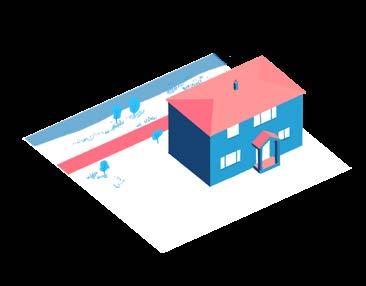
In order to embrace water, the island would need to develop a relationship with it. This relationship would need to be one of dependence and trust, but salt water is not necessarily a friendly element.
Returning to the Topic Research, what if the borders between water and land filtered the water? The solution would combine several factors and mend the relationship between people and water, provide protection from rising sea levels, and make Canvey Island more self-sustainable.
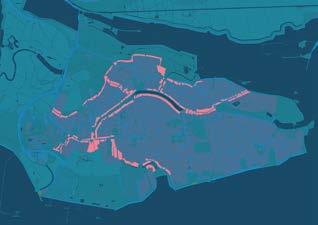
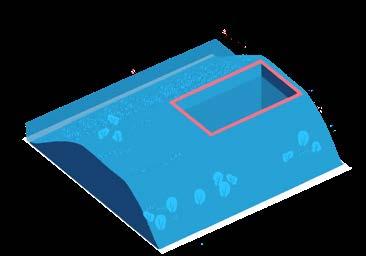
Canvey Lake, currently disconnected from the sea (not tidal) low tide line water well remnants of the house little roof from house could become a bench accessible pathway up
The hill along the water would turn into a filter, creating fresh water that could be stored in the abandoned house. The new border would consist of recycled materials from the houses, create public recreational space, encourage new biodiversity along the water edges, and mend the relationship between people and water, using it as a resource rather than something to fear.
The houses would become water tanks that could be used for swimming pools, fresh drinking water wells, sources of irrigation, and more.
Phytodesalination
The top layer of the filter consists of a mixture of marsh plants but includes a high density of halophyte plants that filter the salt out of the ocean water.

Slow sand filter
The sand layer consists of crushed glass and concrete recycled from the other buildings coming down.
Gravel layer
The gravel filter consists of crushed rubble from concrete and bricks. This layer has slightly larger chunks of rubble than the above layer.
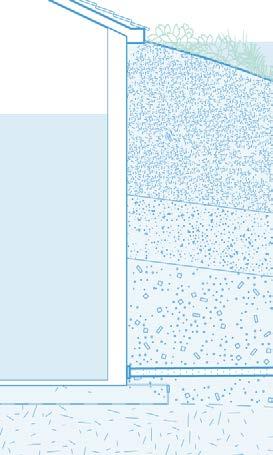
Perforated Pipe House Tank
The water then comes out of the gravel layer and into a perforated pipe at the base of the filter into the house tank.
When the water enters the house tank, it can be used for irrigation and recreation. If used for drinking, essential minerals are put into the water to meet water quality standards.
SEA
GRASSWORTS Salicornia europaea
Less dense planting along lower bank, non-filter area
SEA
SEA
SEA
Tidal wetland planting
Filter line starts here
The water only enters the filter when the water comes up to high tide. The Thames rises and falls nearly seven meters twice every day. This allows large amounts of water to come into each filter. The perforated pipe would be able to be shut to avoid the tanks overflowing and causing flooding.
